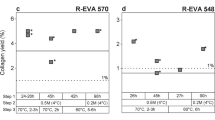Abstract
Bones are potentially the best age indicators in a stratigraphic study, because they are closely related to the layer in which they are found. Collagen is the most suitable fraction and is the material normally used in radiocarbon dating. Bone contaminants can strongly alter the carbon isotopic fraction values of the samples, so chemical pretreatment for 14 C dating by accelerator mass spectrometry (AMS) is essential. The most widespread method for collagen extraction is based on the Longin procedure, which consists in HCl demineralization to dissolve the inorganic phase of the samples, followed by dissolution of collagen in a weak acid solution. In this work the possible side effects of this procedure on a modern bone are presented; the extracted collagen was analyzed by ATR-IR spectroscopy. An alternative procedure, based on use of HF instead of HCl, to minimize unwanted degradation of the organic fraction, is also given. A study by ATR-IR spectroscopic analysis of collagen collected after different demineralization times and with different acid volumes, and a study of an archaeological sample, are also presented.




Similar content being viewed by others
References
Hedges REM, Vanklinken GJ (1992) A review of current approaches in the pretreatment of bone for radiocarbon dating by AMS. Radiocarbon 34(3):279–291
Hedges REM (2002) Bone diagenesis: an overview of processes. Archaeometry 44(3):319–328
Brock F et al (2010) Pre-screening techniques for identification of samples suitable for radiocarbon dating of poorly preserved bones. J Archaeol Sci 37:855–865
Longin R (1971) New method of collagen extraction for radiocarbon dating. Nature 230:241–242
Minami M et al (2004) Chemical techniques to extract organic fractions from fossil bones for accurate 14 C dating. Nucl Instrum Meth B 223–224:302–307
Yizhaq M et al (2005) Quality controlled radiocarbon dating of bones and charcoal from the early Pre-Pottery Neolithic B (PPNB) of Motza (Israel). Radiocarbon 47(2):193–206
Yuan SX et al (2000) Comparison of different bone pretreatment methods for AMS C-14 dating. Nucl Instrum Meth B 172:424–427
Huls CM et al (2008) Ultrafiltration: boon or bane? Radiocarbon 51(2):613–625
Semal P, Orban R (1995) Collagen extraction from recent and fossil bones: quantitative and qualitative aspects. J Archaeol Sci 22(4):463–467
Gallop PM, Seifter S (1963) Preparation and properties of soluble collagens. Meth Enzymol 6:635
van Klinken GJ (1999) Bone collagen quality indicators for palaeodietary and radiocarbon measurements. J Archaeol Sci 26(6):687–695
Beer M et al (1959) Infra-red spectra and structure of proteins. Proc R Soc Lond A 249(1):147–172
Deniro MJ, Weiner S (1988) Chemical, enzymatic and spectroscopic characterization of collagen and other organic fractions from prehistoric bones. Geochim Cosmochim Ac 52(9):2197–2206
Marcheselli G, et al. (2008) The Amphitheatre in Dürres (Albania): a contribution to the chronology of the medieval settlement using luminescence and radiocarbon dating, Int. Congress of Archeometry, poster session
Reimer PJ et al (2009) IntCal09 and Marine09 radiocarbon age calibration curves, 0–50000 years cal BP. Radiocarbon 51(4):1111–1150
Bronk RC (2009) Bayesian analysis of radiocarbon dates. Radiocarbon 51(1):337–360
Author information
Authors and Affiliations
Corresponding author
Rights and permissions
About this article
Cite this article
Maspero, F., Sala, S., Fedi, M.E. et al. A new procedure for extraction of collagen from modern and archaeological bones for 14C dating. Anal Bioanal Chem 401, 2019–2023 (2011). https://doi.org/10.1007/s00216-011-5252-4
Received:
Revised:
Accepted:
Published:
Issue Date:
DOI: https://doi.org/10.1007/s00216-011-5252-4




